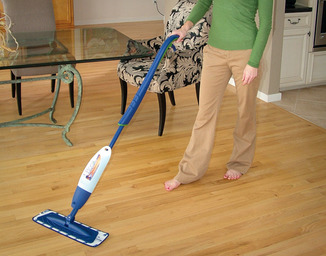Hardwood Floors Care & Maintenance
With today’s advances in wood flooring stains and finishes, cleaning your wood floors has never been easier. Regular maintenance requires little more than sweeping with a soft bristle broom, and vacuuming with a soft floor attachment if your wood floor includes a beveled edge that could collect debris. You also should clean your floors periodically with a professional wood floor cleaning product recommended by a wood flooring professional.
There are other steps you can take to minimize maintenance and maintain the beauty of your wood floors as well.
- Do not use sheet vinyl or tile floor care products on wood floors. Self-polishing acrylic waxes cause wood to become slippery and appear dull quickly.

- Use throw rugs both inside and outside doorways to help prevent grit, dirt and other debris from being tracked onto your wood floors. This will prevent scratching.
- Do not wet-mop a wood floor. Standing water can dull the finish, damage the wood and leave a discoloring residue.
- Wipe up spills immediately with a slightly dampened towel.
- Do not over-wax a wood floor. If a wax floor dulls, try buffing instead. Avoid wax buildup under furniture and other light traffic areas by applying wax in these spots every other waxing session.
- Put stick-on felt protectors under the legs of furniture to prevent scuffing and scratching. Replace these often as dirt and debris can become imbedded on the pad and act like sand paper on the flooring surface.
- Avoid walking on your wood floors with cleats, sports shoes and high heels. A 125-pound woman walking in high heels has an impact of 2,000 pounds per square inch. An exposed heel nail can exert up to 8,000 pounds per square inch. This kind of impact can dent any floor surface.
- When moving heavy furniture, do not slide it on wood flooring. It is best to pick up the furniture completely to prevent scratches.
- For wood flooring in the kitchen, place an area rug in front of the kitchen sink.
- Use a humidifier throughout the winter months to minimize gaps or cracks.
Humidity’s Impact On Your Floor
To protect your investment and ensure that your floor provides lasting satisfaction, the following precautions should be taken to help control humidity levels in and around your floor. For best results, keep the relative humidity in your home between 35% and 55%.
- Heating Season (Dry Conditions) – a humidifier is recommended to prevent excessive shrinkage in hardwood floors, which causes gaps between the boards, due to low humidity levels. Wood stoves and electric heat tend to create very dry conditions.
- Non-Heating Season (Humid and Wet Conditions) – To prevent excessive expansion, cupping and peaking of the floor, which could lead to cracking and checking of the wood finish, maintain proper humidity levels with the use of an air conditioner, dehumidifier or by turning on your heating system periodically during the summer months. Immediately wipe up spills and wet areas to avoid excessive exposure to water. Do not obstruct in any way the expansion joint around the perimeter of your floor.

